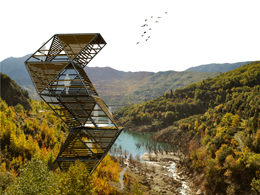STUDENTS PROJECTS
PROJECTS2013

15 May, 2014
Systems of Lightweight Structures
Application in the area of Evinolimni (Evino's lake).
Student: Evgenia Spyridonos
Supervisor: Katherine Liapi
Architecture Department, University of Patras
Presentation date: October 2013
A study about lightweight structures for observation, paths, seating areas based on the capability of multiplication that are being able to adapt into different landscapes, having the minimum impact on the scenery and combine both low cost with environmental friendliness.
To avoid the risk of reducing the water supplies in the city of Athens, a dam was constructed in the highland of Nafpaktos collecting the waters of Evinos River in an artificial lake of 3,500 acres. With an underground tunnel of 32 kilometers, the 25% of Evinos' waters are being transferred to Mornos Lake, arriving finally to Athens. This new ecosystem, called Evinolimni (lake of Evinos), is a rich in natural beauty area that gives a significant boost for alternative eco-development of the mountainous region, creating new activities and new jobs for the local population.
The topography of the area is special, with large height differences and sharp ravines. In the whole region there are streams flowing into the lake. As a consequence of the running waters, there is plenty of green that covers the area. Oak, fir and chestnut trees dominate in the surrounding landscape.
The dam was constructed between 1992 and 2000. Its existence and operation has resulted into the constant variation of water level of the lake that contributes significantly in the alterations of the survey of the area.
In the region around Evinolimni there are many villages, most important of which are five, located around the lake, forming a circular loop around it. These are Agios Dimitrios, Neohori, Arachova, Klepa and Perdikovrisi.

The original goal of this study was to connect these five villages around the lake and to configure a program of local interventions in each of these villages and the surrounding area.
Having visited the site and after observation and study of the area and the surrounding villages, the natural wealth and the specificity of the land relief, led to the decision to avoid any strong or permanent intervention that would negatively affect the scenery. Instead of redeveloping a particular region with permanent elements, it was investigated the possibility of applying various lightweight constructions with zero effect on the soil.
Alongside the specific location, there was a general interest in utilizing relevant areas of natural beauty. Therefore, the aim of this study now was to develop constructions that could adapt into different landscapes and that could also apply in Evinolimni, the surrounding villages, as well as in any relevant in topography area.
The main characteristics of the constructions should be the flexibility to adjust in the landscape, easy construction, transportation and installation and the capability of multiplication. These lightweight structures should have the minimum impact on the landscape by being sustainable and combine both low cost and environmental friendliness. Repeated units and their various combinations along with the capability of those units to be ephemeral would be a viable solution.
The special terrain of Evinolimni led to the need for investigating structures for observation that could be placed in various locations of the topography and permit observation of different levels. Further research was pursued about constructions that could determine paths and seating areas. Impermanent constructions that could create sheltered spaces that would effectively be used for several activities during the year were also taken under consideration.
OBSERVATORIES
The basic construction units used for the observatories are the regular tetrahedron and the regular octahedron. All structures result from the combination of the above two basic units with additional coatings.

The observatories are divided into three categories according to the circulation; the vertical, the horizontal and the irregular.




FOLDING STRUCTURE OF UNIT 2Π
The aim of this construction is the adaptability in the landscape. It unfolds among the trees in order to have the minimum impact on the surrounding environment. It is temporary and it could be used as a seating area or as a path component. Combination of multiple constructions can be used by groups for various outdoor activities.

WOODEN MODULAR CONSTRUCTION
Proposed are wooden structures of repeated units (4x3x2.5m) following a conventional, simply to assemble, construction. The main purpose is the capability to be assembled by anyone.
They form enclosed spaces or remain as open-air constructions. They form space as simple units or even with the gaps created between them. They can be used for constructing temporary spaces for several events or for semipermanent building units with bioclimatic characteristics.
The permanent structure (pavilion), illustrated, whose primary goal was the storage of the units and the components of the structures described above, could generally work as a multipurpose space.

suggested applications:
combinations of the wooden units and its uses


All of the structures were studied separately and as such they could be placed at any scenery. The example of Evinolimni was the source of inspiration of what was finally occurred. Without studying the area and assessing the remarks resulted, taking decisions and establishing goals would be impossible.










